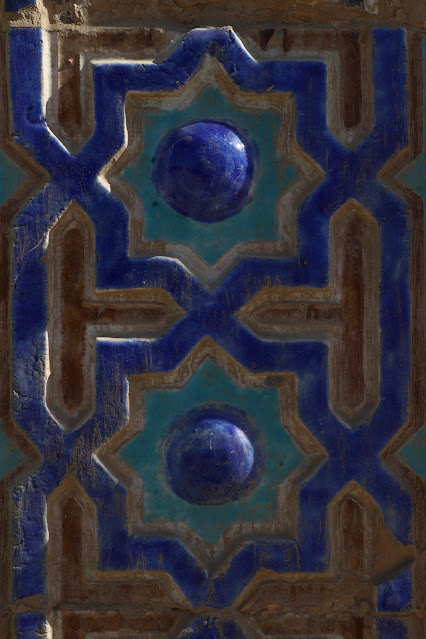Early in this year we started emailing with researchers of the Samarkand State University, and we started to plan together a research project about the restoration possibilities of overgrazed and degraded sandy steppes and semi-deserts. After meeting in the virtual space the next step was even nicer: in July we spent ten days in Uzbekistan, visited the potential study sites in Karnap region and the Kyzyl-Kum desert and we started to plan the details of the research. Dr. Toshpulot Rajabov, the dean of the Agrobiotechnology Institute at the Samarkand State University studies the degradation states of these ecosystems after overgrazing for decades. The plan is that two of his students, Abdubakir and Nodir will come to Hungary for PhD studies and we will study together the restoration prospects of the overgrazed rangelands.
We spent a wonderful time in Uzbekistan. It is truly a wonderful and very interesting country and the people are very friendly and welcoming.
 |
Large part of the country are covered by such heavily grazed rangelands. For the hot summer period the vegetation is dried out and grazed.
|
 |
Young herders.
|
 |
For maintaining a large livestock population, a large amount of supplementary feed is often needed.
|
 |
Discussion at a watering point.
|
 |
The heart of the grazing systems are the watering wells. These are the most heavily used and degraded areas.
|
 |
Horses are coming to the watering well.
|
 |
Next to the watering well, there is the sacrificied zone, which is characterised by high level of trampling and manuring and almost no vegetation.
|
 |
Beautiful but a bit too skinny horses.
|
 |
After some distance from the watering well, the vegetation cover becomes larger.
|
 |
A transitional vegetation in the Karnap region, here we can observe signs of degradation but also the elements of the natural rangeland vegetation.
|
 |
Artemisia diffusa is the most important forage species in these rangelands.
|
 |
Goats are grazing in an Artemisia-dominated pasture.
|
 |
For the summer, the consumable biomass becomes very sparse - at least from this angle it looks like a very poor pasture.
|
 |
From a different perspective at the ground layer we can see that still there is a considerable biomass of grasses and sedges.
|
 |
| Agama. |
 |
Young herders.
|
 |
Iris songarica is an important indicator species of overgrazing and degradation. Now it is not as spectacular as it might be in springtime :)
|
 |
Remnants of a huge camel spider.
|
 |
Tosh asks a herder about the history of the area.
|
 |
Young herders.
|
 |
Two very similar Artemisia species: Artemisia diffusa and A. turanica. The difference is the colour of the stem.
|
 |
This picture synthesises the problems with overgrazing.
|
 |
The best honey melon in the world grows here in the semi-desert region of Uzbekistan. It is soo delicious, nothing like any other melon :)
|
 |
This is one of the oldest buildings in Uzbekistan, situated in Tim village in the Karnap region.
|
 |
The cemetery of Tim village is built around a large kurgan. We have seen several kurgans where in later ages cemeteries have been established.
|
 |
This nice bench with the shadow and cold water is like an oasis in the 47 C degrees :)
|
 |
Alida and I slept in this wonderful tent in the desert. A hotel with thousand stars :)
|
 |
Everywhere we went we saw many kurgans, including huge ones. Here also a cemetery was established later on the body of the kurgan.
|
 |
Similar to Hungary: steppe island on a kurgan surrounded by the sea of the arable field.
|
 |
It is difficult to say wheter kurgans of Rollers (Coracias garrulus) are more abundant in Uzbekistan. We saw many Rollers but only took this one distant picture. In Uzbekistan these birds usually nest in holes in such steep walls.
|
 |
We visited the Zerashan nature reserve near Samarkand. Here lives one of the last populations of red deer (Cervus elaphus) in the country, which is strictly protected so we could observe the dears only behind a fence.
|
 |
White-winged woodpecker (Dendrocopos leucopteros) near the Zerashan river.
|
 |
A natural-like part of the Zerashan river.
|
 |
Capers (Capparis sp.) and yellow starthistle (Centaurea solstitialis) on the riverbank.
|
 |
Caper flower.
|
 |
Common mynas (Acridotheres tristis) like to sit on the cattle.
|
 |
We were quite lucky with vultures, all together we have seen five species. On this picture there is a cinerous vulture (Aegypius monachus).
|
 |
Egyptian vulture (Neophron percnopterus).
|
 |
Himalayan vulture (Gyps himalayensis).
|
 |
A water reservoir on the way to the Zaamin Nature Reserve.
|
 |
Spectacular mountains were all peace of land is grazed.
|
 |
Waterfall in the Zaamin Nature Reserve.
|
 |
The snowy peaks over 4000 m delineate the border between Uzbekistan and Tajikistan.
|
 |
Mountain pasture in Zaamin.
|
 |
Group photo at a gorgeous canyon.
|
 |
Dried yogurt balls in different flavours.
|
 |
Mosaic landscape in Zaamin.
|
 |
During our trip, we spent most evenings in the beautiful Samarkand.
|
 |
| Registan |
 |
Inner courtyard in Registan.
|
 |
| Registan. |
 |
Registan at night.
|
 |
Light show at Registan.
|
 |
Registan in full colour.
|
 |
The Bibi Khanym mosque.
|
 |
Shrubs and grasses grow on the beautiful cupola.
|
 |
Pedestrian street in Samarkand.
|
 |
Huge and very good breakfast.
|
 |
Plov: one of the national dishes.
|
 |
Beautiful ceramics in the bazar of Samarkand.
|
 |
Media attention at the Samarkand State University.
|


































































No comments:
Post a Comment